Finding E-bike Joy as a Tourist Who Cycles VS. a Cyclist Who Tours
Confluence to West Newton |Daily Miles: 54 |Tour Miles: 319
Your bike is discovery; your bike is freedom. It doesn’t matter where you are when you’re on the saddle, you’re taken away – Doug Donaldson.
The Daily Pulse
I rolled out of Confluence on another cool, overcast morning bound for West Newton. The first stretch, about 25 miles through Ohiopyle State Park, is among the most scenic on the Great Allegheny Passage, and one of my personal favorites. From Confluence to Ohiopyle, the trail hugs the river before descending 17 miles through dense forest on the other side of the town of Ohiopyle with the sounds of the rushing water guiding my way to Connellsville.
After passing through Ohiopyle and reaching Connellsville, the character of the ride changes again, the elevation change fades away, giving way to a flatter, easier path toward West Newton. Small communities dot the route, and while the dramatic scenery of Ohiopyle gives way to a quieter landscape. The river still keeps you company, once again winding through the tall, graceful sycamores glowing in autumn color.
There were quite a few people on the trail today. I’ve noticed this October feels busier than past years, with more bike tourists drawn to the GAP’s fall colors, mild temperatures, and relaxed atmosphere. It’s clearly a go-to destination for autumn touring.
Echoes of the Past
In 2011, my friend Chuck and I cycled the Great Allegheny Passage from Pittsburgh eastward. Our first major challenge came at Connellsville, the 17-mile climb through Ohiopyle State Park to the town of Ohiopyle. We had seriously overpacked, and it showed during that long uphill grind. By the time we reached the top, we were exhausted but wiser, fully understanding the true cost of carrying too much gear in our panniers.
That evening in Confluence, we decided to lighten the load. The next morning, I mailed home nearly 20 pounds of excess gear before continuing east. This time around, the experience was entirely different, as I rode downhill instead of climbing, covering miles more quickly and with greater enjoyment. It helped that I was now on an e-bike, which erased the pain and struggle of that earlier trip.
As I rolled out of Ohiopyle today, I came across a large group of middle school students biking from Connellsville to Ohiopyle. Their energy was contagious as they raced along the trail, cheering as they arrived in town. Watching them, I couldn’t help but smile. Those same 17 miles that once challenged me so deeply in 2011 seemed effortless for them today. I pulled aside as a parade of about fifty students rode past, full of life and excitement.
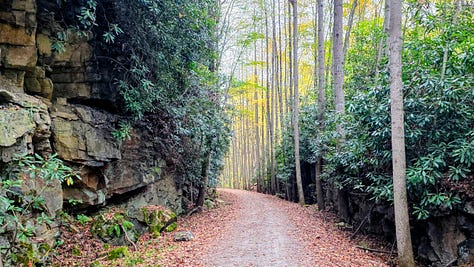
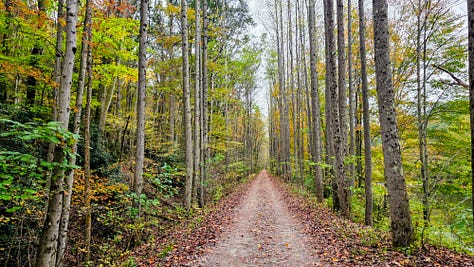

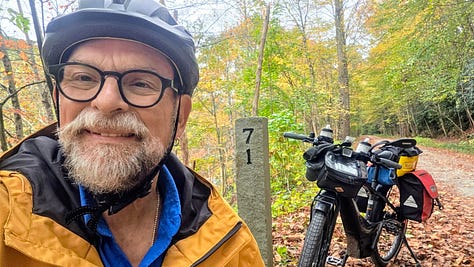
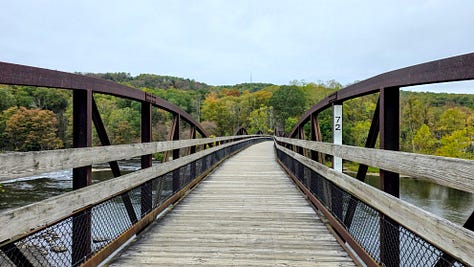
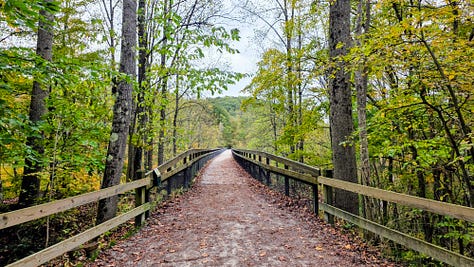

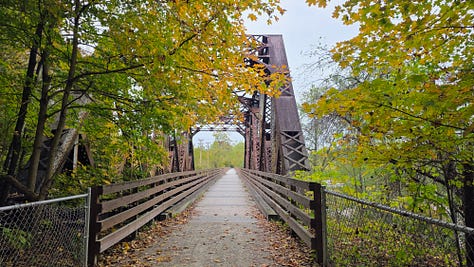

The trail taught me
Battery and Power Management. This week, I’ve spent time getting better acquainted with my e-bike capabilities and limitations by learning how to manage its power and range. On the C&O Canal Trail, I rode mostly at Economy (level 1) about 90% of the time, switching up to Tour (level 2) for the remaining 10%. I typically finished each day with 40–50% battery remaining, a surprisingly efficient result, especially given the unpaved surface of the towpath.
Things changed a bit on the Great Allegheny Passage. Aside from the long climb up Big Savage Mountain, I was again able to ride in Economy (level 1) about 80% of the time and in Tour (level 2) for 20%. The trail surface was smoother overall, but the rolling elevation changes required occasional power boosts. I began the Big Savage climb with 80% battery after 30 miles on the C&O and reached Frostburg with about 40% remaining, pretty reasonable for that ascent.
On the ascent, I discovered a useful rhythm: about every three miles, I’d switch briefly to Sport (level 3) for a mile, then return to level 2. It gave my legs a rest and provided a welcome burst of power. On the steep switchbacks leading into Frostburg, I stayed in Sport mode, both for the extra push and to keep up with traffic on the road section.
The descent from Ohiopyle to Connellsville was the opposite experience. With gravity on my side, I cruised mostly in Economy (level 1), about 90% of the time, with only occasional use of Tour mode.
This tour has been a real learning experience in e-bike battery and power management. I now have a much clearer sense of how elevation and terrain affect daily mileage and the e-bike and my energy use.
One key takeaway: a 60-pound e-bike, 20 pounds of gear, and a 180-pound man demand respect for the battery. Running out of power would make pedaling or walking a serious challenge.
I suppose you could say I’ve earned my stripes as a master of e-bike power management.
Life Reflection
This is my second weeklong e-bike tour of 2025. The first took me 326 miles across the Ohio to Erie Trail, and this one, combining the Great Allegheny Passage and C&O Canal Trail will total 334+ miles. I have to admit, the e-bike has proven itself as my go-to touring bike. Its range is impressive, and it handles hills with ease. I’ve rarely needed to use higher assist levels.
One thing I’ve learned about e-bike touring is how each power level affects my speed. On a fully loaded, non-motorized bike, I typically averaged around 10 mph. With the e-bike, each level adds roughly 2 mph. On Economy (level 1 ), I’m often cruising around 12 mph. That extra couple of miles per hour may not sound like much, but over a full day of riding, it means an extra hour or more at the end of the day, time to relax, explore the town, grab a coffee, or enjoy a beer.
For me, bike touring is about enjoyment, getting away from everyday life, being outdoors, and taking it all in. The e-bike lets me do that without finishing each day spent. Many riders tour for the challenge, pushing limits, climbing every hill under their own power, and I respect that. I used to ride that way myself. But these days, that’s no longer my top priority.
Now, I understand why so many casual long-distance cyclists are embracing e-bikes. They make touring more accessible, comfortable, and fun, especially for riders who want to focus on the journey rather than the grind. I often say that every rider must decide: Are you a cyclist who tours, or a tourist who cycles?
If your goal is to chase miles and conquer climbs, you’re a cyclist who tours. But if your priority is the experience, the scenery, the people, the culture, then you’re a tourist who cycles, using the e-bike as a way to fully experience the world around you.
Tomorrow, I’ll pedal into Pittsburgh, wrapping up a memorable week on the trail, one blessed with great weather and the kind of joy that reminds me why I love touring in the first place.



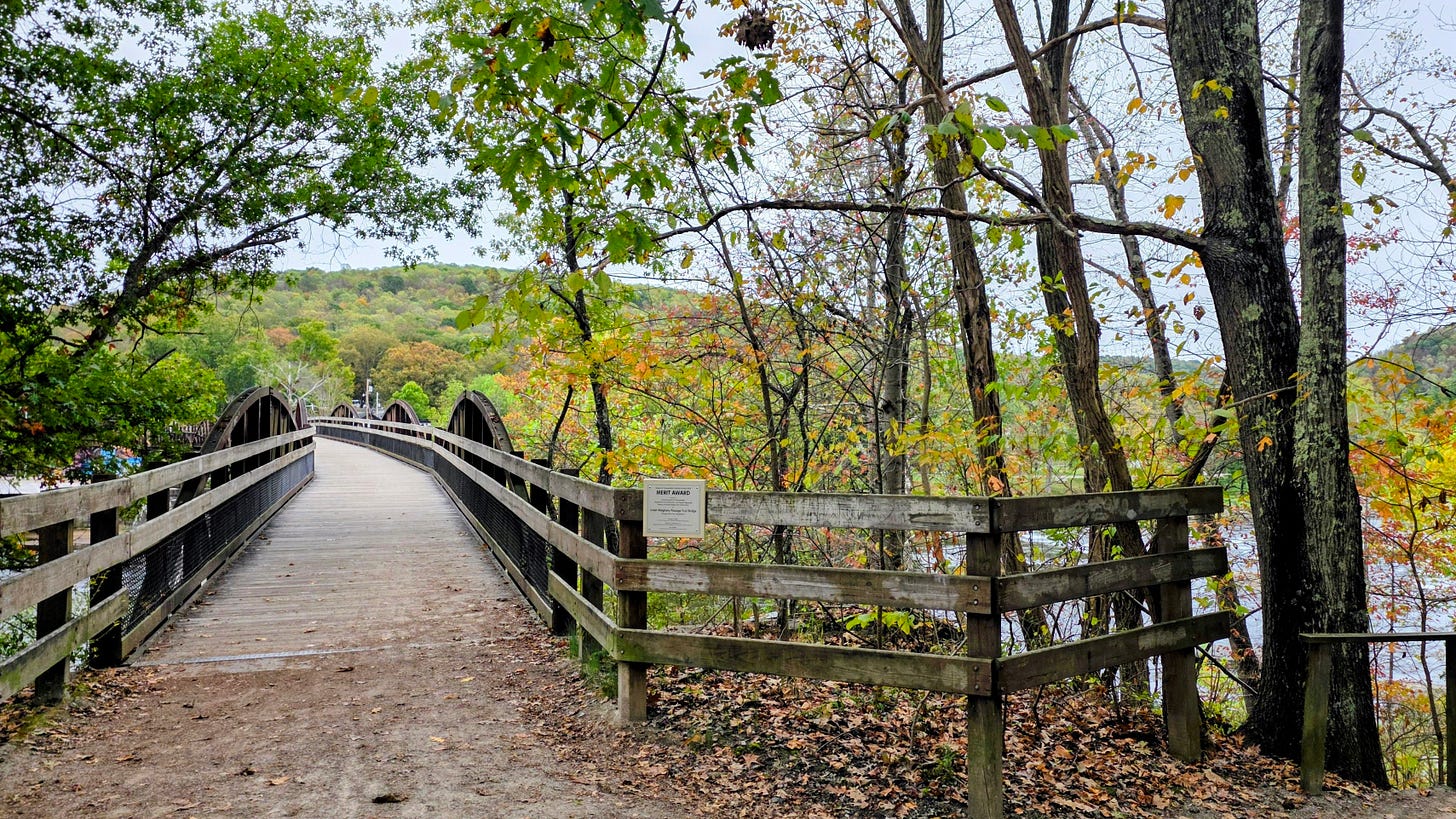

I am thinking about getting an e-bike myself. Maybe I missed this in your excellent trip reports, but what type of e-bike do you have?